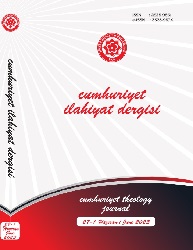Secâvendî’ye Göre Kur’ân’daki Vakf-ı Lâzım Remizlerinde Vasl Yapmanın Anlama Etkisi
The Effect of Making Joining (Vasl) on the Purpose of Stopping (Waqf) in the Holy Qur’an According to Sajawandi
Author(s): Hasan BulutSubject(s): Hermeneutics, Qur’anic studies
Published by: Cumhuriyet Üniversitesi İlahyat Fakültesi
Keywords: Qur’an; Recitation; Meaning; Sajawandi; Stopping (Waqf); Joining (Vasl);
Summary/Abstract: Every word of the Qur’an aims to provide an understanding of the divine will. The stopping (waqf) signs in it were created for this purpose. Just like the punctuation marks that ensure the correct understanding of a Turkish sentence, the waqf marks in the Holy Qur’an are also placed for the same reason. The signs of waqf, which give the opportunity to breathe by interrupting the recitation at the places where the meaning is completed, and other signs which provides the recitation starting from the appropriate place for the integrity of the meaning, have significant importance in the authentic reading and interpretation of the Qur’an. Hz. The Prophet himself learnt how to read the Qur’an with the support of Gabriel (as) and then taught it to the Companions as he read it. The Companions tried to recite in the way that the Messenger of Allah had instructed, and strongly avoided adding too much and attributing deficiencies to the verses of the Qur’an. Likewise, they recited the Qur’an with Tajwid, giving every letter its due and taking into account the stop signs. In this context, Ali (Died in 40/661) defined the word “tertil” in the Qur’an as “knowing the Tajwid of letters and stops” and drew attention to the importance and seriousness of the issue of waqf and Ibtida. In later periods, authors such as Abu Bakr Ibn al- Enbari (Died in 328/940), Abu Ja’fer al-Nehhas (Died in 338/950), Abu Amr al-Dânî (Died in 444/1053) have been composed valuable works. However, the scholar, who brought an independent topic under the name of “Sajawand” to the science of recitation and wrote very important works related to the field, is undoubtedly Muhammad b. Tayfur al-Sajawandi (Died in 560/1165). The waqf that constitutes the main axis of our study is the waqf that is dealt with in Sajawandi’s classification of waqfs and indicated by the Ramz ( م) in the manuscripts. Waqf Lazim is a type of ijtihadi style waqf that is considered essential to be emphasized and even considered obligatory in many places. In this context, Sajawandi has justified his claim that “if a joining (vasl) is made in a word, if the nature and meaning of the verse changes, it is obligatory to make a stop” with the examples he gave from the Qur’an. Although there are scholars who consider it “haram” to make a vasl in wording with a need for a waqf ( م), İbn al-Jazari (Died in 833/1429) stated that there is no waqf that is described as wajib or haram in the Qur’an. Waqfs made in a way that deliberately distorts or degrades the meaning of the verse have never been regarded as credible, and it has been stated that foundations can be made in any suitable word for any reasonable reason. Waqf Lazim is different from other types of waqfs. Although the word is complete in Waqf Tam, there is no connection between word and meaning with the next word. However, in the Waqf Lazim, in addition to the reason for this disconnection, it is also taken into account whether making vasl causes i’rab and change of the meaning. Because when vasl is used in a word with a sign of waqf, the i’rab and meaning of the verse change. In Waqf Mutlaq, reading it by making a vasl does not change the i’rab and meaning of the verse. Accordingly, while making a stop in a Waqf Mutlaq and Waqf Kafi is a reason for preference, it is obligatory in Waqf Lazim. Although it is not permissible to do vasl due to a change in meaning in Waqf Lazim, it is permissible to do vasl in Waqf Mutlaq and Waqf Kafi. According to Sajawandi, in a place where the word in the verses is complete, if the next sentence is the beginning sentence and the joining (vasl) is made, the change of the i’rab and the notion of the verse necessitates making a waqf in this place. The symbol of this obligation is denoted by the sign ( م). Not every waqf with the sign of Waqf Lazim has to be a Waqf Tam, Waqf Kafi or Waqf Hasen; just as every waqf does not have to be a Waqf Lazim. However, the choice of foundation in some places with the sign of the need for foundation may sometimes include the reasons of waqf Mutlaq, waqf kafi or waqf hasen. These justifications make Waqf Lazim different from other types of waqfs. So, in this study, the signs of Waqf Lazim in our country’s mushafs, which prefer Sajawandi’s waqf system, will be examined within the framework of verse integrity. It will be analyzed why Sajawandi considers it necessary to make a waqf, taking into account the possible meanings that may occur in the case of joining (vasl). In addition, the verses that Sajawandi determined as a Waqf Lazim and Nîsâbûrî (Born in 730/1329) joined him for the same reasons were chosen as examples, and these places, which are seen as the most essential to be focused on, were also evaluated in terms of i’rab.
Journal: Cumhuriyet İlahiyat Dergisi
- Issue Year: 27/2023
- Issue No: 1
- Page Range: 120-135
- Page Count: 16
- Language: Turkish

